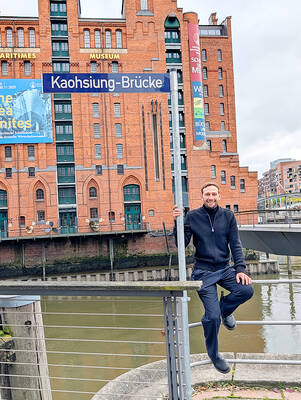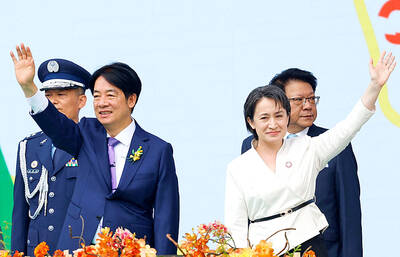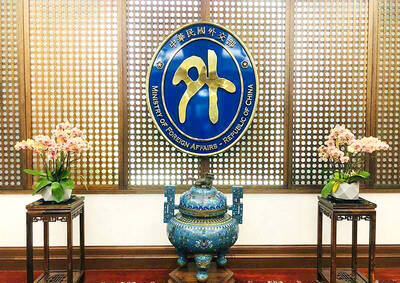The Qinghai-Tibet railway completed last year is a "tool of conquest" that serves to strengthen China's "colonial rule" in Tibet, Tibetan rights activists said yesterday during a conference on human rights in Tibet.
Yesterday was the second and final day of the International Symposium on Human Rights in Tibet, held in Taipei by the Mongolian and Tibetan Affairs Commission and co-organized by the Taiwan Culture Foundation and Taiwan Friends of Tibet.
The construction of the 1,956km Qinghai-Tibet railway that connects Xining, capital of Qinghai Province, and Lhasa, the capital of Tibet, began in the 1970s.
However, as a result of technical difficulties, the construction was halted after the section from Xining to Golmud was completed.
In 2001, more advanced engineering technology allowed for construction of the rail line to resume. The Golmud-Lhasa section was finally completed and came into service last year.
Although the Chinese government said the construction of the railroad was for the welfare of Tibetans, Tibetan rights activists see it otherwise.
"A railway can be a tool of conquest," said John Ackerly, director of the International Campaign for Tibet.
"During colonial times, railways can be used as a tool of colonial rule and resource extraction," Ackerly said.
Zeng Shan (
"In the 1980s, mining authorities in China discovered three rare minerals in Tibet: Chromium, sylvite and gold," Zeng told the audience.
"With the railroad completed, the transportation costs of the minerals can be lowered by a large margin -- however, I doubt local Tibetans will benefit much from the extraction of their resources," Zeng said.
Rinchen Tashi, deputy director for the International Campaign for Tibet, voiced other concerns.
"Operation of the railroad has strengthened Beijing's political control over Tibet and sped immigration to the center and west of Tibet as well as the assimilation of Tibetan culture," he said.
Ruan Ming (阮銘), consultant with the Taiwan Research Institute, said the railroad is essentially good and important for economic development in Tibet, but warned that "it should be a good tool for Tibetans, but [only] in the hands of Tibetans."
Participants' opinions were divided when it came to what Tibet support groups worldwide should do as the 2008 Beijing Olympics approach.
Willy Fautre, president of Human Rights without Frontiers International, said that groups should pressure heads of state to turn down the invitation to participate in the games.
However, Ross Terrill, a senior East Asian research scholar at Harvard University, disagreed and believed that all heads of state should accept the invitation.
While they are in Beijing, they should "hold a joint press conference on human rights," Terrill said. "That would be much more powerful."

The German city of Hamburg on Oct. 14 named a bridge “Kaohsiung-Brucke” after the Taiwanese city of Kaohsiung. The footbridge, formerly known as F566, is to the east of the Speicherstadt, the world’s largest warehouse district, and connects the Dar-es-Salaam-Platz to the Brooktorpromenade near the Port of Hamburg on the Elbe River. Timo Fischer, a Free Democratic Party member of the Hamburg-Mitte District Assembly, in May last year proposed the name change with support from members of the Social Democratic Party and the Christian Democratic Union. Kaohsiung and Hamburg in 1999 inked a sister city agreement, but despite more than a quarter-century of

Taiwanese officials are courting podcasters and influencers aligned with US President Donald Trump as they grow more worried the US leader could undermine Taiwanese interests in talks with China, people familiar with the matter said. Trump has said Taiwan would likely be on the agenda when he is expected to meet Chinese President Xi Jinping (習近平) next week in a bid to resolve persistent trade tensions. China has asked the White House to officially declare it “opposes” Taiwanese independence, Bloomberg reported last month, a concession that would mark a major diplomatic win for Beijing. President William Lai (賴清德) and his top officials

The Ministry of Foreign Affairs (MOFA) yesterday expressed “grave concerns” after Singaporean Prime Minister Lawrence Wong (黃循財) reiterated the city-state’s opposition to “Taiwanese independence” during a meeting with Chinese Premier Li Qiang (李強). In Singapore on Saturday, Wong and Li discussed cross-strait developments, the Singaporean Ministry of Foreign Affairs said in a statement. “Prime Minister Wong reiterated that Singapore has a clear and consistent ‘one China’ policy and is opposed to Taiwan independence,” it said. MOFA responded that it is an objective fact and a common understanding shared by many that the Republic of China (ROC) is an independent, sovereign nation, with world-leading

‘ONE CHINA’: A statement that Berlin decides its own China policy did not seem to sit well with Beijing, which offered only one meeting with the German official German Minister for Foreign Affairs Johann Wadephul’s trip to China has been canceled, a spokesperson for his ministry said yesterday, amid rising tensions between the two nations, including over Taiwan. Wadephul had planned to address Chinese curbs on rare earths during his visit, but his comments about Berlin deciding on the “design” of its “one China” policy ahead of the trip appear to have rankled China. Asked about Wadephul’s comments, Chinese Ministry of Foreign Affairs spokesman Guo Jiakun (郭嘉昆) said the “one China principle” has “no room for any self-definition.” In the interview published on Thursday, Wadephul said he would urge China to